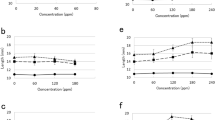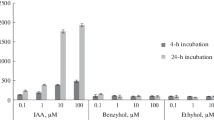Abstract
Two sesquiterpene lactones belonging to the germacranolides were isolated from the leaves and stems of Helianthus annuus L. Their formation in the plant is light-dependent. Both sesquiterpene lactones (SL) strongly inhibit indole-3-acetic acid (IAA)-induced elongation growth of Avena sativa L. coleoptile segments and Helianthus annuus L. hypocotyl segments. Both SL do not, however, inhibit acid-induced growth nor growth triggered by fusicoccin at all. In the presence of dithiothreitol (DTT), the inhibitory effect of SL in the Avena-segment-test can be completely neutralized. This can be attributed to the binding of DTT to both SL. Using thin-layer-chromatography it could be shown that the inhibitors build adducts with SH-rich compounds, e.g., cysteine, glutathione, mercapto-ethanol, and DTT, whose Rf-value significantly differs from those of the primary substances. If the coleoptile segments are first treated with an inhibitor and the inhibitor is subsequently washed out, close to normal elongation growth can be induced by adding an IAA-solution. If the segments are simultaneously treated with inhibitor and IAA, no notable growth can be initiated for an extended amount of time, after the removal of both substances and the anewed addition of IAA. Fusicoccin, however, can immediately neutralize the induced growth inhibition. The same irreversible inhibition is observed when 2,4-dichlorophenoxyacetic acid (2,4-D) is used: If coleoptile segments are treated with an inhibitor plus 2,4-D or an inhibitor plus 3,5-dichlorophenoxyacetic acid (3,5-D), respectively, IAA-induced growth after removal of the substances can only be observed by those coleoptiles which had previously been treated with the non-auxin, 3,5-D plus an inhibitor. Based on these results, a possible mechanism describing how the inhibitor functions is discussed. The binding of an auxin to an auxin receptor sets a SH-group free (possibly due to a change in the conformation of the receptor); a site is given to which the inhibitor can bind irreversibly (via a S-bond). The IAA-receptor-inhibitor-complex is then no longer able to initiate elongation growth. If auxin is not present, no lasting bond between the inhibitor and the receptor can occur, since the essential SH-group remains masked. The inhibitor can be washed out again. Consequently, the SL's have to be able to intervene at the beginning of the IAA-induced reaction sequence, while the following steps remain uninfluenced, i.e. namely, the active excretion of protons into the cell wall compartments, which is directly induced by fusicoccin and causes elongation growth.
Similar content being viewed by others
Abbreviations
- 2,4-D:
-
2,4-dichlorophenoxy-acetic acid
- 3,5-D:
-
3,5-dichlorophenoxy-acetic acid
- DTT:
-
dithiothreitol
- FC:
-
Fusicoccin
- GA3 :
-
gibberellic acid
- IAA:
-
indole-3-acetic acid
- MES:
-
2-(N-morpholino)-ethane sulfonic acid
- SL:
-
sesquiterpene lactone(s)
References
Baruah, N.C., Sharma, R.P., Madhusudanam, K.P., Thyagarajan, G., Herz, W., Murari, R. (1979) Sesquiterpene lactones of Tithonia diversifolia. Stereochemistry of tagitinins and related compounds. J. Org. Chem. 44, 1831–1835
Bates, G.W., Cleland, R.E. (1979) Protein synthesis and auxininduced growth: inhibitor studies. Planta 145, 437–442
Cleland, R.E. (1971) Cell wall extension. Annu. Rev. Plant Physiol. 22, 197–222
Cleland, R., Rayle, D. (1978) Auxin, H+-excretion and cell elongation. Bot. Mag., Special issue 1, 125–139
Dohrmann, U., Hertel, R., Kowalik, H. (1978) Properties of auxin binding in different subcellular fractions from maize coleoptiles. Planta 140, 97–106
Hager, A. (1962) Untersuchungen über einen durch H+-Ionen induzierbaren Zellstreckungsmechanismus. Habil. Schrift, Naturwiss. Fakultät, Universität München
Hager, A. (1980) Avena coleoptile segments: hyperelongation growth after anaerobic treatment. Z. Naturforsch. 35c, 794–804
Hager, A., Frenzel, R., Laible, D. (1980) ATP-dependent proton transport into vesicles of microsomal membranes of Zea mays coleoptiles. Z. Naturforsch. 35c, 783–793
Hager, A., Helmle, M. (1981) Properties of an ATP-fueled Cl--dependent proton pump localized in membranes of microsomal vesicles from maize coleoptiles. Z. Naturforsch. 36c, 997–1008
Hager, A., Hermsdorf, P. (1981) H+/Ca2+ antiporter in membranes of microsomal vesicles from maize coleoptiles, a secondary energized Ca2+ pump. Z. Naturforsch. 36c, 1009–1012
Hager, A., Menzel, H., Krauss, A. (1971) Versuche und Hypothese zur Primärwirkung des Auxins beim Streckungswachstum. Planta 100, 47–75
Hegnauer, R. (1964) Chemotaxonomie der Pflanzen, vol. 3, pp. 447–544. Birkhäuser, Basel
Heroult V. (1971) Chemotaxonomy of the family Compositae. In: Pharmacognosy and phytochemistry, pp. 93–110, Wagner, H., Hörhammer, L., eds, Springer, Berlin Heidelberg New York
Heroult, V., Sorm, F. (1969) Chemotaxonomy of the sesquiterpenoids of the Compositae. In: Perspectives in phytochemistry, pp. 139–165, Harborne, J.B., Swain, T., eds. Academic Press, London New York
Hertel, R. (1979) Auxin receptors in plant membranes: subcellular fractionation and specific binding assays. In: Plant organelles. Methodological surveys in biochemistry, vol. 9, pp. 173–183, Reid, E., ed. Ellis Horwood, Chichester
Herz, W., Sharma, R.P. (1975) A trans-1,2-cis-4,5-germacranolide and other new germacranolides from Tithonia species. J. Org. Chem. 40, 3118–3123
Herz, W., Kumar, N. (1981) Heliangolides from Helianthus maximiliani. Phytochemistry 20, 93–98
Kalsi, P.S., Vij, V.K., Singh, O.S., Wadia, M.S. (1977) Terpenoid lactones as plant growth regulators. Phytochemistry 16, 784–786
Kalsi, P.S., Gupta, D., Dhillon, R.S., Arora, G.S., Talwar, K.K., Wadia, M.S. (1981) Plant growth activity of guaianolides with C-4 oxygen-containing groups. Phytochemistry 20, 1539–1542
Kefeli, V.J., Kadyrov, C.S. (1971) Natural growth inhibitors, their chemical and physiological properties. Annu. Rev. Plant Physiol. 22, 185–196
Kefeli, V.J. (1977) Natural plant growth inhibitors and phytohormones. Dr. W. Junk. The Hague
Krauss, A. (1971) Untersuchungen zum Streckungswachstum der Pflanzen. Diss., Ludwig-Maximilians-Universität, München
Kupchan, S.M., Fessler, D.C., Eakin, M.A., Giacobbe, T.J. (1970) Reactions of alpha methylene lactone tumor inhibitors with model biological nucleophiles. Science 168, 376–378
Lado, P., Caldogno, F.R., Pennachioni, A., Marrè, E. (1973) Mechanism of growth promoting action of fusicoccin. Planta 110, 311–320
Lee, K.-H., Ibuka, T., Wu, R.-Y., Geissmann, T.A. (1977a) Structure-antimicrobial activity relationships among the sesquiterpene lactones and related compounds. Phytochemistry 16, 1177–1181
Lee, K.-H., Hall, J.H., Mar, E.C., Starnes, C., El Gebaly, S.A., Waddell, T.G., Hadgraft, R.J., Ruffner, c.G., Weidner, J. (1977b) Sesquiterpene antitumor agents: inhibitors of cellular metabolism. Science 196, 533–536
Marrè, E. (1977) Effect of fusicoccin and hormones on plant cell membrane activities: Observations and hypothesis. In: Regulation of cell membrane activities in plants, pp. 185–201, Marrè, E., Ciferri, O., eds. Elsevier-North-Holland, Amsterdam
Marrè, E. (1979) Fusicoccin: a tool in plant physiology. Annu. Rev. Plant Physiol. 30, 273–288
Ogura, M., Cordell, G.A., Farnsworth, N.R. (1978) Anticancer sesquiterpene lactones of Michella compressa. Phytochemistry 17, 957–961
Ohno, N., Mabry, T.J. (1980) Sesquiterpene lactones and diterpene carboxylic acids in Helianthus niveus. Phytochemistry 19, 609–614
Powell, R.G., Smith, C.R. (1980) Antitumor agents from higher plants. Recent Adv. Phytochem. 14, 23–51
Ray, P.M. (1977) Auxin-binding sites of maize coleoptiles are localized on membranes of endoplasmatic reticulum. Plant Physiol. 59, 594–599
Rayle, D.L., Cleland, R. (1972) The in-vitro acid-growth response: relation to in-vivo growth response and auxin action. Planta 104, 282–296
Rayle, D.L., Cleland, R.E. (1977) Control of plant cell enlargement by hydrogen ions. Curr. Top. Dev. Biol. 34, 187–214
Rodriguez, E., Towers, G.H.N., Mitchell, J.C. (1976) Biological activities of sesquiterpene lactones. Phytochemistry 15, 1573–1580
Rubery, P.H. (1981) Auxin receptors. Annu. Rev. Plant Physiol. 32, 569–596
Sequeira, L., Hemingway, R.J., Kupchan, S.M.(1968) Vernolepin: A new reversible plant growth inhibitor. Science 161, 789–790
Shibaoka, H. (1961) Studies on the mechanism of growth inhibiting effect of light. Plant Cell Physiol. 2, 175–197
Spring, O., Albert, K., Gradmann, W. (1981) Annuithrin, a new biologically active germacranolide from Helianthus annuus Phytochemistry 20, 1883–1885
Spring, O., Albert, K., Hager, A. (1982) New biologically active heliangolides from Helianthus annuus. Phytochemistry 21, (in press)
Spring, O., Kupka, J., Maier, B., Hager, A. (1982) Biological activities of sesquiterpene lactones from Helianthus annuus: Antimicrobial and cytotoxic properties; influence on DNA, RNA and protein synthesis. Z. Naturforsch. 37c (in press)
Venis, M.A. (1977) Receptors for plant hormones. Adv. Bot. Res. 5, 53–88
Willuhn, G. (1981) Neue Ergebnisse der Arnikaforschung. Pharmazie in unserer Zeit 10, 1–7
Author information
Authors and Affiliations
Rights and permissions
About this article
Cite this article
Spring, O., Hager, A. Inhibition of elongation growth by two sesquiterpene lactones isolated from Helianthus annuus L.. Planta 156, 433–440 (1982). https://doi.org/10.1007/BF00393314
Received:
Accepted:
Issue Date:
DOI: https://doi.org/10.1007/BF00393314




